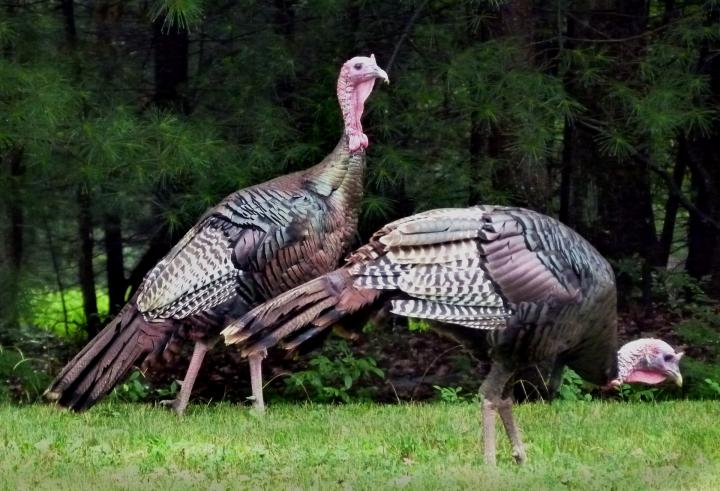The Wild Turkey: History of an All-American Bird
Subhead
All About Wild Turkeys
For daily wit & wisdom, sign up for the Almanac newsletter.
The American Wild Turkey has become an iconic symbol of Thanksgiving. Perhaps a brief history of our native bird is in order. Learn turkey trivia and everything you ever wanted to know about the Wild Turkey.
Wild Turkeys in the Americas
- The first description of the turkey was written by Oviedo in 1525 in his General and Natural History of the Indies.
- Native Americans first raised domestic turkeys in Mexico and Central America, and they bred them into domestication from a subspecies of the North American Wild Turkey, possibly as early as 25 A.D.
- Spanish explorers took some of those domesticated turkeys back to Europe around 1519. They spread rapidly among European farmers and were popular fare among the elites.
- In 1541, Archbishop Cranmer ordered that large fowl such as cranes, swans, and turkeys “should be but one in a dish.” Turkey became a common dish at all festivals in England during the 1500s and was the usual fare at Christmas Dinner.
The Turkeys’ Return to the Americas!
- Turkeys returned to the Americas with English colonists in Virginia and Massachusetts in the early 1600s. Those colonists were surprised to learn that Native Americans were already tapped into the native Wild Turkey that had been part of the American landscape all along.
- John James Audubon once had a pet turkey in Henderson, Kentucky, that he caught when it was two days old. The turkey became the favorite of the village and followed anyone who called it. At age 2 years, it flew off and did not return. A while later, Audubon ordered his dog to chase a large gobbler that he saw during a 5-mile walk. The turkey paid no attention to the dog, and Audubon realized it was his favorite pet because it was unafraid of the dog.
To Extinction and Back
- Turkeys were numerous in oak and chestnut forests in Massachusetts. From 1711 to 1717, they sold at market for 1 shilling 4 pence, but by 1820, the birds had significantly declined, and the price had increased 10-fold. The last turkey was killed in Massachusetts in 1821.
- During much of the 20th century, Wild Turkeys almost became extinct due to habitat loss. However, due to an ambitious relocation program, the Wild Turkey can now be found in large numbers in every state in the United States except Alaska.
In New Hampshire, we often see Wild Turkeys in wooded areas at this time of year, enjoying plant nuts and berries. Cars stop in awe of these beautiful birds meandering through the forest.

Wild Turkey Facts
The Wild Turkey is different from its factory-farmed cousin, which can be found in grocery stores. Domestic turkeys are big business today.
- Young turkey birds are called poults, and adolescents are called jakes.
- As soon as 24 hours after hatching, a young poult is up and running around in search of food.
- When a turkey is excited, its head can change color to red, pink, white, or blue.
- A Wild Turkey can run as fast as 25 miles per hour. The domestic turkey, on the other hand, has been bred through hundreds of generations to have shorter legs and is much slower on its feet.
- The Wild Turkey can fly more than a mile at a time and at speeds up to 55 miles per hour. The domestic turkey has been bred to have outsized, meaty breasts, sacrificing its ability to fly along the way.
- Wild turkeys are wary, difficult to catch, and have acute eyesight, while domestic turkeys have no fear of humans.
- You will find that Wild Turkeys sleep in trees, roosting high up in the branches every night.
Brief History of Wild Turkeys
- In the early 1800s, Alexander Wilson provided so much information on the natural history of the turkey in his encyclopedic American Ornithology that John James Audubon could not truly improve on the knowledge of the species in his later book, Birds of America.
- Commenting on the national seal’s design, Benjamin Franklin disparages the Bald Eagle, writing that the eagle was “a bird of bad moral character.” When the idea of the turkey is raised, he expresses preference, stating that “the Turkey is in Comparison a much more respectable Bird, and withal a true original Native of America… a Bird of Courage, and would not hesitate to attack a Grenadier of the British Guards who should presume to invade his Farm Yard with a red Coat on.”
We hope you learned something to talk about at the Thanksgiving table.
For more Wild Turkey facts, see our Turkey Trivia page.
About The Author
Catherine Boeckmann
Catherine Boeckmann loves nature, stargazing, and gardening so it’s not surprising that she and The Old Farmer’s Almanac found each other. She leads digital content for the Almanac website, and is also a certified master gardener in the state of Indiana.
Read More from Catherine Boeckmann










